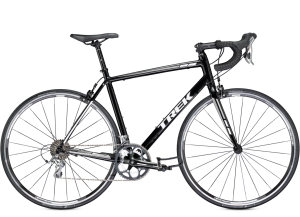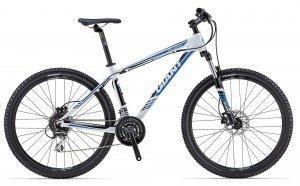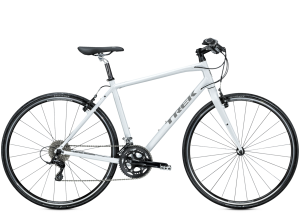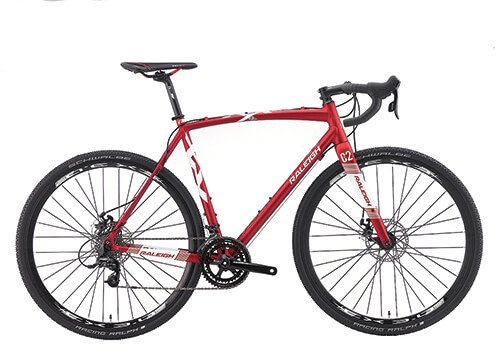Buyers Guide to Bikes
So you are in the market for a new bike but there are so many styles to choose from. Do you want a hybrid or a road bike? And what is the difference? If you buy a mountain bike will it be alright for commuting to work by road? We have taken four of the more popular styles and put together a basic buyers guide to bikes their differences.
Road Bikes
 Recognisable by their 'drop handlebars' road bikes are often referred to as racing bikes because of their lightweight aerodynamic frames and 'skinny' tyres. Road bikes have become evermore popular in recent years thanks to the successes of Team GB Cycling, Team Sky Pro Cycling and high-profile riders like Sir Bradley 'Wiggo' Wiggins. Made from a variety of materials including Steel, Titanium or the more popular Carbon-fibre or (usually) cheaper Aluminium (Alloy), road bikes are built with a wide gear range. Historically this would be anywhere between 5 and 16 speeds but modern road bikes tend to start with 12-14 gears and can go up to 22 speed with a double chainset or even 30 speed with a triple chainset. Manufactures tend to put 16, 18 or 20 speeds on their mid-priced bikes. Retro road bikes had the gear shifters mounted on the down tube of the bike frame. Nowadays the gear shifters are built in with the brake levers allowing for quick, responsive gear changing. The brakes on road bikes are more commonly a 'side pull' U-brake caliper but more and more manufactures are launching lightweight road bikes with disc brakes. The standard adult (men's) road bike wheels are measured at 700c (622mm diameter) and the tyres most commonly measure a narrow 23mm. Alternative tyre sizes are available but it is worth checking that the bike frame will support wider tyres. When choosing a road bike, be careful with the sizing. Like clothing or footwear, road bike sizing can be very different between manufactures. If you are unable to get to your local bike shop to sit on a few models, most cycling websites give pretty accurate size guides (usually from the manufacturer). If you have chosen to buy a bike online it is always worth contacting the dealer and speaking to their experts before clicking 'Checkout'!
Recognisable by their 'drop handlebars' road bikes are often referred to as racing bikes because of their lightweight aerodynamic frames and 'skinny' tyres. Road bikes have become evermore popular in recent years thanks to the successes of Team GB Cycling, Team Sky Pro Cycling and high-profile riders like Sir Bradley 'Wiggo' Wiggins. Made from a variety of materials including Steel, Titanium or the more popular Carbon-fibre or (usually) cheaper Aluminium (Alloy), road bikes are built with a wide gear range. Historically this would be anywhere between 5 and 16 speeds but modern road bikes tend to start with 12-14 gears and can go up to 22 speed with a double chainset or even 30 speed with a triple chainset. Manufactures tend to put 16, 18 or 20 speeds on their mid-priced bikes. Retro road bikes had the gear shifters mounted on the down tube of the bike frame. Nowadays the gear shifters are built in with the brake levers allowing for quick, responsive gear changing. The brakes on road bikes are more commonly a 'side pull' U-brake caliper but more and more manufactures are launching lightweight road bikes with disc brakes. The standard adult (men's) road bike wheels are measured at 700c (622mm diameter) and the tyres most commonly measure a narrow 23mm. Alternative tyre sizes are available but it is worth checking that the bike frame will support wider tyres. When choosing a road bike, be careful with the sizing. Like clothing or footwear, road bike sizing can be very different between manufactures. If you are unable to get to your local bike shop to sit on a few models, most cycling websites give pretty accurate size guides (usually from the manufacturer). If you have chosen to buy a bike online it is always worth contacting the dealer and speaking to their experts before clicking 'Checkout'!
Mountain Bikes (Mtb's)
 Mountain bikes or off-road bikes or Mtb's are built for riding on rough terrain. Their frames are usually more compact and smaller than road bikes and their tubing much thicker (or over-sized). This it to make the bike strong enough to deal with the impact of riding over rocking trials but agile enough to maneuver over and around obstacles. The handlebars are flat or raisers, meaning there is a slight rise either side of the handlebar stem. Like with the road bikes the frames are usually built from Aluminium (Alloy), Carbon-fibre and even Titanium. Unlike the road bike, the mountain bike uses thumb shifters for gear changing, which are usually situated above or below the handlebars. The brakes are more often disc brakes although older styles and low prices mountain bikes still use a pulley style V-brake system. There are 2 main types of frame build in this range of bikes. HARD TAIL mountain bikes are so called because the rear and main body of the frame is solid but the front forks have a suspension mechanism often referred to as 'shocks'. The suspension forks are designed to absorb impact to the front of the bike whilst riding off-road (or on some roads). Some suspension forks have a 'lock-out' switch which allows the rider to make the front forks rigid. This is often used when riding on roads as a rigid frame is much smoother and easier to ride at speed. The alternative option is a FULL SUSPENSION mountain bike. Like the HARD TAIL these bikes come with suspension forks at the front but instead of having a rigid body, the bike is almost split into a 3rd section at the rear. This is then joined to the main body of the frame by a 'rear shock' which usually sits in front or just behind the seat tube. Whilst some riders may use these bikes on the road, they are really designed for off-road, down hill use. Mountain bike wheels now come in 3 adult sizes of 26", 27.5" and 29". The tyres are much deeper and thicker than that on road bikes and often have very deep tread patterns for maximum grip on rough or muddy terrain.
Mountain bikes or off-road bikes or Mtb's are built for riding on rough terrain. Their frames are usually more compact and smaller than road bikes and their tubing much thicker (or over-sized). This it to make the bike strong enough to deal with the impact of riding over rocking trials but agile enough to maneuver over and around obstacles. The handlebars are flat or raisers, meaning there is a slight rise either side of the handlebar stem. Like with the road bikes the frames are usually built from Aluminium (Alloy), Carbon-fibre and even Titanium. Unlike the road bike, the mountain bike uses thumb shifters for gear changing, which are usually situated above or below the handlebars. The brakes are more often disc brakes although older styles and low prices mountain bikes still use a pulley style V-brake system. There are 2 main types of frame build in this range of bikes. HARD TAIL mountain bikes are so called because the rear and main body of the frame is solid but the front forks have a suspension mechanism often referred to as 'shocks'. The suspension forks are designed to absorb impact to the front of the bike whilst riding off-road (or on some roads). Some suspension forks have a 'lock-out' switch which allows the rider to make the front forks rigid. This is often used when riding on roads as a rigid frame is much smoother and easier to ride at speed. The alternative option is a FULL SUSPENSION mountain bike. Like the HARD TAIL these bikes come with suspension forks at the front but instead of having a rigid body, the bike is almost split into a 3rd section at the rear. This is then joined to the main body of the frame by a 'rear shock' which usually sits in front or just behind the seat tube. Whilst some riders may use these bikes on the road, they are really designed for off-road, down hill use. Mountain bike wheels now come in 3 adult sizes of 26", 27.5" and 29". The tyres are much deeper and thicker than that on road bikes and often have very deep tread patterns for maximum grip on rough or muddy terrain.
Hybrid and City Bikes
 A very popular choice with regular commuters, hybrid bikes offer comfort, speed and durability. Also known as city or coummter bikes, the frame build and design sits somewhere between road bike and mountain bike. Made from the similar materials, the tubing on a hybrid is thin and lightweight like a road bike but it's geometry means you sit more like a mountain bike. The handlebars are flat (or raisers) like on a mountain bike and the gear shifters are also thumb shifters like that of a mountain bike. Most hybrid bike wheels are 700c (622mm) the same as road bikes although because of the setup of the build of the frame, the rear wheel and front fork spacing is usually wider to accommodate wider tyre widths. Hybrids will come equipped with 28mm, 32mm or 35mm tyres which have a level of grip but not as intense as that on a mountain bike. These are often very hard-wearing so ideal for riding on busy city streets. The brakes on a hybrid can be anything from a U-brake caliper or a V-brake to a full disc brake setup. It really depends on the manufacturer and the cost of the bike. Disc brakes will tend to appear on the mid to high priced hybrid and city bikes. These are also great bikes for when it comes to carrying. A lot of bikes of this type will have fixings for the purpose of adding pannier racks for carrying heavy bags. And usually there will be sufficient room for fitting mudguards, making hybrids a great bike for all-year-round.
A very popular choice with regular commuters, hybrid bikes offer comfort, speed and durability. Also known as city or coummter bikes, the frame build and design sits somewhere between road bike and mountain bike. Made from the similar materials, the tubing on a hybrid is thin and lightweight like a road bike but it's geometry means you sit more like a mountain bike. The handlebars are flat (or raisers) like on a mountain bike and the gear shifters are also thumb shifters like that of a mountain bike. Most hybrid bike wheels are 700c (622mm) the same as road bikes although because of the setup of the build of the frame, the rear wheel and front fork spacing is usually wider to accommodate wider tyre widths. Hybrids will come equipped with 28mm, 32mm or 35mm tyres which have a level of grip but not as intense as that on a mountain bike. These are often very hard-wearing so ideal for riding on busy city streets. The brakes on a hybrid can be anything from a U-brake caliper or a V-brake to a full disc brake setup. It really depends on the manufacturer and the cost of the bike. Disc brakes will tend to appear on the mid to high priced hybrid and city bikes. These are also great bikes for when it comes to carrying. A lot of bikes of this type will have fixings for the purpose of adding pannier racks for carrying heavy bags. And usually there will be sufficient room for fitting mudguards, making hybrids a great bike for all-year-round.
Cyclo-cross (CX) Bikes
 Cyclocross bikes have similar frames to road racing bikes. They are lightweight with generally thin tubing. They have a bigger tyre clearance than that of a road bike. The tyres themselves whilst still being relatively thin (usually around 35mm) have a much deeper 'knobbly' tread pattern than a road or hybrid bike to allow maximum grip over wet and muddy terrain like that on a mountain bike. Brakes were traditionally cantilever or V-brakes but disc brakes are quickly becoming the norm for most manufacturers. The bikes is much stronger than that of a road bike but is lightweight to allow Cyclocross competitors to carry the bikes over obstacles. The geometry of the frame tends to be different from both road and mountain bikes. The top tube tends to be horizontal as opposed to sloping (or compact) like a road or mountain bike. This is makes it easier to carry. And where as some road bike and mountain bikes riders have their saddle height raised, cyclocross tends to have a lower seating position to make it easier and quicker to re-mount after climbing muddy hills or obstacles. The gearing is lower than that of a road bike with a chainset having a 46/36t (tooth) and the cassette having an 11-32t (tooth) spread. Because the cyclocross bikes use 'drop' handlebars the same as a road bike, the brakes and shifters are the same. But it will be common to see mountain bike-style brake levers in the centre of the handlebars. The wheels are also similar to road bikes and will often fall under the same category when shopping online but usually have an oversized flange and stronger hub to increase the wheels stiffness. Whilst cyclocross bikes are perhaps more specialist than the other types of bikes here, they do also make a great all rounder for anytime of the year.
Cyclocross bikes have similar frames to road racing bikes. They are lightweight with generally thin tubing. They have a bigger tyre clearance than that of a road bike. The tyres themselves whilst still being relatively thin (usually around 35mm) have a much deeper 'knobbly' tread pattern than a road or hybrid bike to allow maximum grip over wet and muddy terrain like that on a mountain bike. Brakes were traditionally cantilever or V-brakes but disc brakes are quickly becoming the norm for most manufacturers. The bikes is much stronger than that of a road bike but is lightweight to allow Cyclocross competitors to carry the bikes over obstacles. The geometry of the frame tends to be different from both road and mountain bikes. The top tube tends to be horizontal as opposed to sloping (or compact) like a road or mountain bike. This is makes it easier to carry. And where as some road bike and mountain bikes riders have their saddle height raised, cyclocross tends to have a lower seating position to make it easier and quicker to re-mount after climbing muddy hills or obstacles. The gearing is lower than that of a road bike with a chainset having a 46/36t (tooth) and the cassette having an 11-32t (tooth) spread. Because the cyclocross bikes use 'drop' handlebars the same as a road bike, the brakes and shifters are the same. But it will be common to see mountain bike-style brake levers in the centre of the handlebars. The wheels are also similar to road bikes and will often fall under the same category when shopping online but usually have an oversized flange and stronger hub to increase the wheels stiffness. Whilst cyclocross bikes are perhaps more specialist than the other types of bikes here, they do also make a great all rounder for anytime of the year.
Final thought -
These are the basics in terms of the differences between the most popular styles of bikes on the market. As we said in our 'Getting Started' article, whether you have decided on the style of bike you want or not, do your research! Go to your local bike shop or speak to the experts at the online stores. The last thing you want to do is invest money in a bike that after a few months you decide is not the right seating position, or the right style for the type of riding you are doing. When you get your bike, enjoy it.Ride safe!AATR

